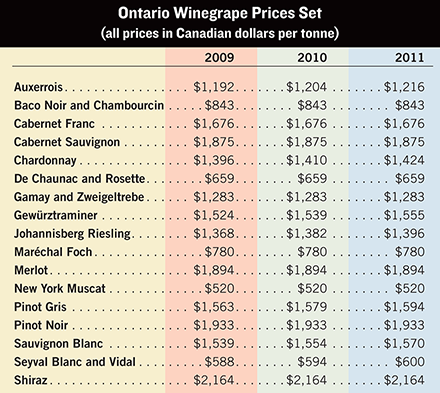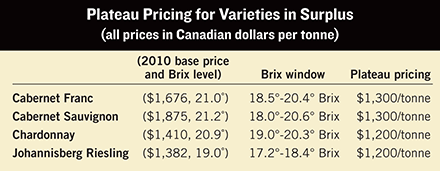Ontario White Winegrapes Up 1%
Prices for reds stable as negotiators debut two-year agreement

The negotiators made news in three ways: They set prices for two years at once, they included the new Winery & Grower Alliance of Ontario for the first time, and they created a pilot program that allows wineries to buy low-sugar grapes at discounted prices from a few varieties that are in surplus.
Several other prices related to late-harvest wines or ice wines remain unchanged. The minimum price for ice wine grapes is 125% of the price based on normal harvest. Ice wine juice prices, in Canadian dollars, are: hybrid juice: $15.76 per liter at 35°Brix, and vinifera juice: $24.16 per liter at 35°Brix. The price for late-harvest hybrid juice stays at $4.58 per liter at 26° Brix.
The negotiations covered winegrapes only. In Ontario, labrusca varieties are classified as juice grapes rather than winegrapes. Prices for these varieties will be set later this summer through negotiations between the Grape Growers of Ontario and a separate committee of processors.
New model for grapes in oversupply
This year, for the first time, a pilot pricing model attractive to some of the larger wineries was established for Chardonnay, Riesling, Cabernet Sauvignon and Cabernet Franc, four varieties that are currently in oversupply. What is called the plateau pricing model will be in effect for the 2010 vintage only and will be evaluated after the harvest to determine whether the pilot project should be continued in 2011 and if other varieties should be added. The intent is to move more tonnage of these varieties by pricing them at lower levels than were negotiated in 2009.

Plateau pricing is limited to deliveries made within the Brix window shown for each variety. Deliveries at higher Brix levels must be paid for at the 2009 base price plus applicable sugar bonuses. Processors must advise growers well before harvest of their intent to purchase grapes at plateau pricing, and growers are encouraged to work with their processors to ensure that their grapes are harvested within the plateau pricing range.
Three-way negotiations
This was the first time that three industry groups were involved in the negotiations. In the past, representatives of the Grape Growers of Ontario and the Wine Council of Ontario were the only ones at the bargaining table. Last year several large wineries that produce both VQA and blended wines left the Wine Council and formed the Winery and Grower Alliance of Ontario. Negotiations were difficult at times, but there was a common goal of finding a way to help growers sell more grapes and reduce the surplus of grapes that has been an industry problem for the past two years.
The pilot plateau pricing system gives wineries the option of buying lower cost grapes of varieties in surplus. These cheaper, lower Brix grapes will be used in blended wines or Cellared in Canada wines. Growers of higher quality fruit that requires more work in the vineyard should receive higher prices per tonne. Negotiators expected that last year’s surplus of 8,000 tonnes will be cut in half this year.
Ed Madronich, president of the Wine Council, says that the two-year agreement will give wineries and growers a period of calm to work through such problems as managing grape surpluses and the frequently contentious price negotiations of the past.